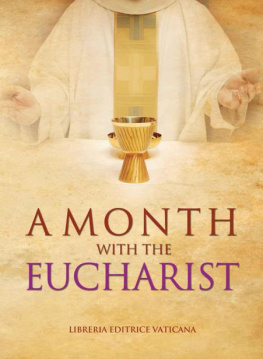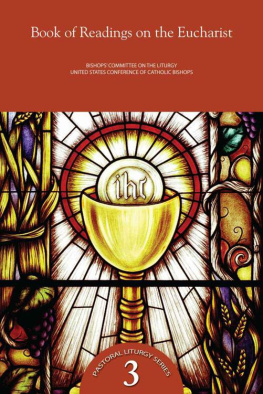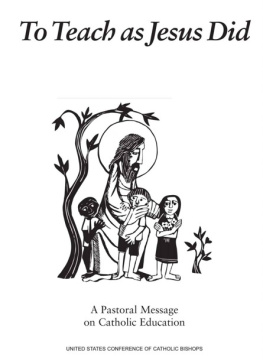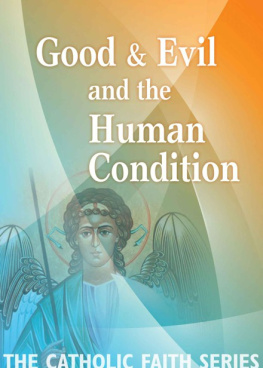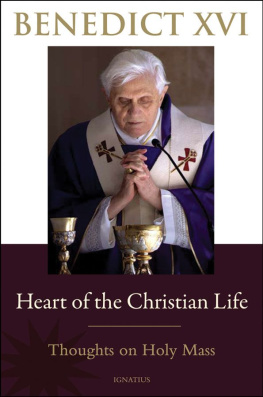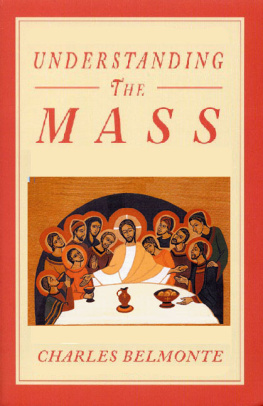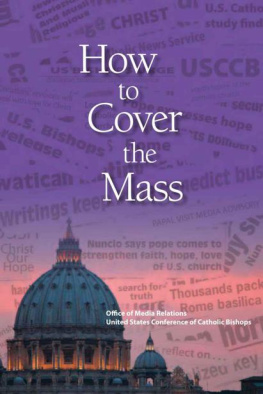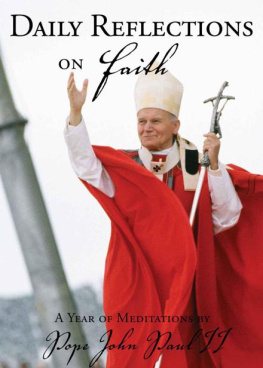United States Conference of Catholic Bishops - A Month with the Eucharist
Here you can read online United States Conference of Catholic Bishops - A Month with the Eucharist full text of the book (entire story) in english for free. Download pdf and epub, get meaning, cover and reviews about this ebook. year: 2012, genre: Religion. Description of the work, (preface) as well as reviews are available. Best literature library LitArk.com created for fans of good reading and offers a wide selection of genres:
Romance novel
Science fiction
Adventure
Detective
Science
History
Home and family
Prose
Art
Politics
Computer
Non-fiction
Religion
Business
Children
Humor
Choose a favorite category and find really read worthwhile books. Enjoy immersion in the world of imagination, feel the emotions of the characters or learn something new for yourself, make an fascinating discovery.
- Book:A Month with the Eucharist
- Author:
- Genre:
- Year:2012
- Rating:4 / 5
- Favourites:Add to favourites
- Your mark:
- 80
- 1
- 2
- 3
- 4
- 5
A Month with the Eucharist: summary, description and annotation
We offer to read an annotation, description, summary or preface (depends on what the author of the book "A Month with the Eucharist" wrote himself). If you haven't found the necessary information about the book — write in the comments, we will try to find it.
United States Conference of Catholic Bishops: author's other books
Who wrote A Month with the Eucharist? Find out the surname, the name of the author of the book and a list of all author's works by series.
A Month with the Eucharist — read online for free the complete book (whole text) full work
Below is the text of the book, divided by pages. System saving the place of the last page read, allows you to conveniently read the book "A Month with the Eucharist" online for free, without having to search again every time where you left off. Put a bookmark, and you can go to the page where you finished reading at any time.
Font size:
Interval:
Bookmark:
WITH THE
EUCHARIST
Giuseppe Santoro
Libreria Editrice Vaticana
United States Conference of Catholic Bishops
Washington, DC
MENSIS EUCHARISTICUS
A MONTH WITH THE EUCHARIST
The following introduction by Cardinal Giovanni Coppa appeared in the Italian/Latin edition of Mensis Eucharisticus. While it contains notes particular to the Italian translation, the full text is included here for its contribution to the context of the book .
T his golden bookletit certainly merits such a descriptionwas published by the Tipografia Vaticana in 1969 and given to members of the Secretariat of State. Since then I have used it, and use it still, every day. The booklet has long been out of print, and my own copy is in a poor condition. For this reason, inspired by the success of the Year for Priests, I thought to have the book reprinted, adding the Italian translation, which I present to my brother priests.
The author is unknown, as Giuseppe Santoro indicates in the Note that precedes the Preface. The question of its origins merits further research, which however is not feasible here for reasons of space and practicality. Still, whoever the author was, the reflections offered here are of such fragrance and profundity, as the editor himself says, as to be a great source of Eucharistic spirituality.
The booklet is structured around a conventional calendar month of thirty-one days: for each day, there are reflections devoted to preparing for Mass and for giving thanks, divided into three parts and followed by an invocation. Each daily reflection is informed by a definition, a name, a mystery belonging to Christ, fully alive in the Eucharist: Brother, Lord, Teacher, Spouse, Friend, Savior, Healer, Light, Food, Lord of Hosts, Heir, Bread of God, Suffering Servant, High Priest, Fire, Precious Stone, Tree of Life, and so on. The text invites the priest to come near to him before and after the Mass, weaving the particular passages chosen for each day into a richly diverse tapestry of biblical references. The continuous faceting, so to speak, of the Eucharistic mystery is based wholly on the Word of God, with numerous biblical references (323, to be precise), which fills every page of the book with biblical wisdom, theological substance, and a vibrant spirituality. I would say that the author tried to do as the Risen Jesus did with the confused disciples at Emmaus: Then, beginning with Moses and all the prophets, he interpreted to them what referred to him in all the scriptures (Lk 24:27). Indeed, the reflections in this little book help us to understand better everything written about Christ in the Law of Moses, the Prophets, and in the Psalms (see Lk 24:44). It is a difficult task, to be sure, but one that is accomplished with great simplicity and with a masterful command of the Bible.
I am confident that this work, which is being offered anew, not only will satisfy the wishes of the Servant of God Paul VI, expressed in the conclusion of this work (see Preparation for the Sacrifice of the Mass , no. 8), but also corresponds fully to Benedict XVIs call in the 2007 apostolic exhortation Sacramentum Caritatis for a profound mystagogical catechesis as the way to an ever greater intimate and lived understanding of the Eucharist: The mature fruit of mystagogy is an awareness that ones life is being progressively transformed by the holy mysteries being celebrated (no. 64c). Focusing attention on the priest in particular, the Holy Father added, Priestly spirituality is intrinsically eucharistic... In order to give an ever greater eucharistic form to his existence, the priest... should make his spiritual life his highest priority. He is called to seek God tirelessly... An intense spiritual life will enable him to enter more deeply into communion with the Lord and to let himself be possessed by Gods love, bearing witness to that love at all times, even the darkest and most difficult (no. 80).
The present work helps us to do that. We all should hope that the celebration of the Divine Sacrifice, lived with the intense and serious biblical, theological, and spiritual atmosphere that is found in this booklet will stimulate in all priests an increased sense of the mystery of God present among us (ibid., no. 65) and will help them to approach the altar with the proper transparency of heart and purity of body that is the kind of witness the Church and the world expect of them today.
CARDINAL GIOVANNI COPPA
- The biblical quotations in A Month with the Eucharist , in both the Latin and Italian version, are listed in a single Index of Biblical Quotations at the end of this book, at pp. 151-156.
- The biblical quotations in the Latin version of A Month with the Eucharist were taken from the Clementine Vulgata (see Bibliorum Sacrorum , edited by A. Gramatica, Tipografia Vaticana, 1951), but the editor at times used them very loosely, either for general references or without any reference at all, so that the interpretation (and the translation) do not correspond to the biblical passages cited. In the Index of Biblical Quotations, all such citations are preceded by cf .
- The biblical quotations in Italian were taken from the editio princeps of the CEI (Italian Episcopal Conference) and reprinted in La Sacra Bibbia , CEI-UELCI, Roma 2008. Certain Latin versions from the Vulgata were considered where necessary, in particular for the purposes of interpretation.
- In the Latin version, spelling, capitalizations, and punctuation were left unchanged from the 1969 edition. The Index of Biblical Quotations preserves the abbreviations used by the editor Santoro, although some of them were updated to conform to current usage.
- The quotations found in the concluding Latin version ( Sententiae de Missae celebratione ), which often were imprecise if not incorrect, have all been cross-referenced with the original editions, except in a few cases where it was necessary to consult a reliable secondhand source. As a result, the quotations cited in the Italian translation ( Pensieri sulla celebrazione della Messa ) often do not correspond with the Latin version, but the present Italian translation should be considered to be accurate.
A s the reader will note from the Introduction, this little golden bookletwhose author and origins remain something of a mysterywas edited by Fr. Giuseppe Santoro and published in Latin by the Vatican Typography in 1969. Then, as now, the Mensis Eucharisticus was intended as a spiritual guide for priests to help them prepare to celebrate Mass, in keeping with Paul VIs encyclical Mysterium Fidei (1965). Fr. Santoro appreciated that the many pressing demands on a priests time often made it difficult for a celebrant to collect his thoughts before or after Mass. Santoro hoped that the reflections contained herein could offer as much meaningful insight as longer prayer since, as he observed, they are brief but dense with feeling and meaning. This is owing to the structure and content of the text. As Cardinal Giovanni Coppa notes in the Introduction to his recent Italian translation of the booklet ( Il Mese Eucaristico , Citt del Vaticano: Libreria Editrice Vaticana, 2011), the reflections are organized along the lines of a standard calendar month of thirty-one days. Daily reflections invite the priest both to prepare for Mass and to give thanks afterward; each reflection is inspired and informed by some biblical passage or symbol; taken together, the text constitutes what Cardinal Coppa describes evocatively as a rich diverse tapestry in which the Eucharistic mystery unfolds by the very means of the Word of God.
The present edition is an English translation of Cardinal Coppas Italian edition of the Mensis Eucharisticus . Readers will note, however, that the biblical references reproduced in the present edition are drawn directly from the New American Bible, Revised Edition (NABRE, 2011). Further, its readers should note that the original Latin and Italian texts adapted biblical quotations or references freely and somewhat loosely. In some instances, these were direct quotations drawn from a scriptural source, but often a word, phrase, or title was interspersed by the author as part of a longer passage. In some cases, both the original Latin and Italian editions use direct quotations with accompanying quotation marks and citations; yet often they have not done so, even when the text in question is drawn directly from a biblical source. For the sake of consistency and to respect as much as possible the voice and intent of the original, the present edition has adopted the same practice. To avoid any confusion, as with the Latin and Italian versions, the present edition provides a precise citation for all biblical references, whether these are indicated by direct quotations or interspersed in the text itself. Finally, readers will note that wherever possible, the English translations of other sources, such as papal encyclicals or letters, are drawn from official English translations with full bibliographical information provided.
Font size:
Interval:
Bookmark:
Similar books «A Month with the Eucharist»
Look at similar books to A Month with the Eucharist. We have selected literature similar in name and meaning in the hope of providing readers with more options to find new, interesting, not yet read works.
Discussion, reviews of the book A Month with the Eucharist and just readers' own opinions. Leave your comments, write what you think about the work, its meaning or the main characters. Specify what exactly you liked and what you didn't like, and why you think so.

